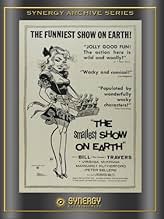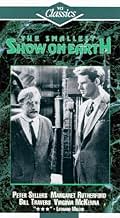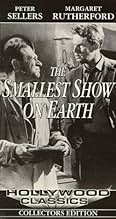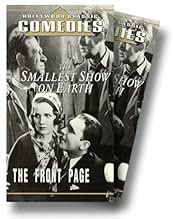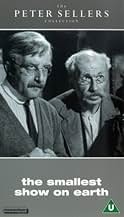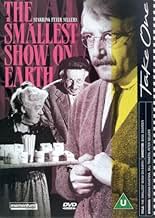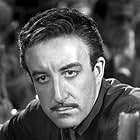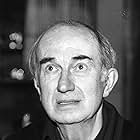IMDb RATING
7.0/10
2.3K
YOUR RATING
A young couple inherits a debt-ridden old movie theater, appropriately nicknamed "The Flea Pit", and the three eccentric senior citizens who work there.A young couple inherits a debt-ridden old movie theater, appropriately nicknamed "The Flea Pit", and the three eccentric senior citizens who work there.A young couple inherits a debt-ridden old movie theater, appropriately nicknamed "The Flea Pit", and the three eccentric senior citizens who work there.
- Nominated for 1 BAFTA Award
- 1 nomination total
Francis De Wolff
- Albert Hardcastle
- (as Francis de Wolff)
The Blake Twins
- Cast Members
- (uncredited)
Terry Burton
- The First Customer
- (uncredited)
John Bush
- Cast Member
- (uncredited)
Ted Carroll
- Bijou Cinema Patron
- (uncredited)
Jimmy Charters
- Bijou Cinema Patron
- (uncredited)
Storyline
Did you know
- TriviaThe production insurers declined to cover Dame Margaret Rutherford, so all of her scenes were squeezed into seven days.
- GoofsWhen the young couple arrive in "Sloughborough", in the north of England, they climb out of the taxi in front of Hammersmith underground station in London.
- Quotes
Hardcastle: A nice young couple like yourself, you've no business in this business. If you'd seen your great uncle what it did for him in the end! That old battle-ax Mrs. Fazackalee! I remember when she was a wee slip of a thing, pretty as a picture - a "B" picture, mind yuh!
[laughs]
- ConnectionsFeatured in A Bit of Scarlet (1997)
- SoundtracksGod Save the Queen
(uncredited)
trad.
Featured review
'THE SMALLEST SHOW ON EARTH' may not have been exactly that since there were certainly smaller, but it was a case of a fictional small "electric theatre" (the once British way of differentiating a movie theatre from a legitimate theatre or 'music hall,' as they designated their version of the American vaudeville). This delightful British film is as heart warming and sometimes hilarious as the other reviewers here describe, but it is the wonderful interaction between the story, the sets, and the actors that balance the film and make it a classic. This 19th century 'kinema' was styled in the manner of the traditional British 'music hall' of live performers, but held early projection equipment (hence the double entendre about projectionist Peter Sellers' 'equipment.') Such asides will be over the heads of the kiddies, but the pleasant pacing and careful dialogue of the actors will please the adults for whom this comedy is intended.
The story of a young couple inheriting a cinema and finding that it is not quite the money-maker they imagined would have been prosaic were it not for the clever settings and the three fossils who maintained the old "Bijou" (French for 'jewel'). If it were ever a jewel, it had lost its luster as the years passed and patrons flocked to the newer nearby movie palace, the "Grand." Desperate to keep their jobs, the 'fossils' (veteran scene-stealers: Peter Sellers, Margaret Rutherford, and Bernard Miles) took pains to refresh the old place to please new owner Bill Travers, a too seldom used actor of mild presence but uniquely suited to this role. The character of the Bijou's "commissionaire" (doorman, janitor, and boiler keeper) Miles in the end tries too hard and creates the only jarring note in the film, which is otherwise tender and memorable. The device of having latter day elevated trains roar past the cinema was inspired and created some memorable scenes, as when the building shakes to the slow start up of the train, or when Bill Travers' character is almost rattled off the ladder as he attempts to relight the old roof sign. There are many wonderful sight gags and other fine bits that one will long remember.
For those who also like old theatres, it may be of interest to know that the exterior of the Bijou was actually a set created at the meeting of two existing elevated train bridges on Christchurch Ave. at the Kilburn LT station in London. The interior was also a set, but so well done that you would swear that you were in a real 19th century 'opera house.' The design is thought to be derived from the real Palace of Varieties at Camberwell. The movie palace with the pipe organ - "the Grand" - was actually the Gaumont Palace (later the Odeon, now Apollo) in Hammersmith, London. And the use of the fictional name of "Sloughborough" for the town is another little joke since it means 'low place or mire.' These details can be confirmed in the journal of the British "Cinema Theatre Association's" magazine "PICTURE HOUSE," No. 19, Winter 93-94, pages 37 and 38, (where there are photos in this and the previous issue) furnished to this reviewer courtesy of Mr. Brian J. Hall of England.
One reviewer said that the only flaw was that the story was too short and I must concur in that, and that is the only real flaw I can find in the film as well. There is a difficulty, however, in appreciating the quality of the film from the most common versions of the VHS-NTSC format videos now available. IMDB/Amazon lists two ASIN numbers of versions made by the same French Canadian firm, Madacy, which produced them in EP speed, rather than the usual SP speed that allows for quality. Since Amazon never indicates the speed of a tape, I cannot tell if their third variation produced by 'VCI Classics (American Prudential)' is also in this slow speed of poor quality. Not only is the image poor, but the sound is downright difficult to understand! Amazon's sister company, The Internet Movie Data Base, now lists two CD versions about to be released, and we can but hope that they were made from restored masters and are the pleasure that the original film is.
P.S.: Two years before the movie "Majestic" (starring Jim Carrey) debuted, the director wrote on the THEATRE HISTORICAL SOCIETY'S web site that he was searching for information about historic theatres for his forthcoming unnamed movie. This reviewer responded with information and said that the description of it he gave sounded something like "The Smallest Show on Earth." He responded that he was amazed that anyone remembered the 1956 British film, but that it was indeed an inspiration for his movie. Look closely at the lobby in "Majestic" and you will see it clearly resembles that in the 'Bijou,' even if the facades were much different. These films turned out very differently, but at least the architecture rewards lovers of theatres
The story of a young couple inheriting a cinema and finding that it is not quite the money-maker they imagined would have been prosaic were it not for the clever settings and the three fossils who maintained the old "Bijou" (French for 'jewel'). If it were ever a jewel, it had lost its luster as the years passed and patrons flocked to the newer nearby movie palace, the "Grand." Desperate to keep their jobs, the 'fossils' (veteran scene-stealers: Peter Sellers, Margaret Rutherford, and Bernard Miles) took pains to refresh the old place to please new owner Bill Travers, a too seldom used actor of mild presence but uniquely suited to this role. The character of the Bijou's "commissionaire" (doorman, janitor, and boiler keeper) Miles in the end tries too hard and creates the only jarring note in the film, which is otherwise tender and memorable. The device of having latter day elevated trains roar past the cinema was inspired and created some memorable scenes, as when the building shakes to the slow start up of the train, or when Bill Travers' character is almost rattled off the ladder as he attempts to relight the old roof sign. There are many wonderful sight gags and other fine bits that one will long remember.
For those who also like old theatres, it may be of interest to know that the exterior of the Bijou was actually a set created at the meeting of two existing elevated train bridges on Christchurch Ave. at the Kilburn LT station in London. The interior was also a set, but so well done that you would swear that you were in a real 19th century 'opera house.' The design is thought to be derived from the real Palace of Varieties at Camberwell. The movie palace with the pipe organ - "the Grand" - was actually the Gaumont Palace (later the Odeon, now Apollo) in Hammersmith, London. And the use of the fictional name of "Sloughborough" for the town is another little joke since it means 'low place or mire.' These details can be confirmed in the journal of the British "Cinema Theatre Association's" magazine "PICTURE HOUSE," No. 19, Winter 93-94, pages 37 and 38, (where there are photos in this and the previous issue) furnished to this reviewer courtesy of Mr. Brian J. Hall of England.
One reviewer said that the only flaw was that the story was too short and I must concur in that, and that is the only real flaw I can find in the film as well. There is a difficulty, however, in appreciating the quality of the film from the most common versions of the VHS-NTSC format videos now available. IMDB/Amazon lists two ASIN numbers of versions made by the same French Canadian firm, Madacy, which produced them in EP speed, rather than the usual SP speed that allows for quality. Since Amazon never indicates the speed of a tape, I cannot tell if their third variation produced by 'VCI Classics (American Prudential)' is also in this slow speed of poor quality. Not only is the image poor, but the sound is downright difficult to understand! Amazon's sister company, The Internet Movie Data Base, now lists two CD versions about to be released, and we can but hope that they were made from restored masters and are the pleasure that the original film is.
P.S.: Two years before the movie "Majestic" (starring Jim Carrey) debuted, the director wrote on the THEATRE HISTORICAL SOCIETY'S web site that he was searching for information about historic theatres for his forthcoming unnamed movie. This reviewer responded with information and said that the description of it he gave sounded something like "The Smallest Show on Earth." He responded that he was amazed that anyone remembered the 1956 British film, but that it was indeed an inspiration for his movie. Look closely at the lobby in "Majestic" and you will see it clearly resembles that in the 'Bijou,' even if the facades were much different. These films turned out very differently, but at least the architecture rewards lovers of theatres
- How long is Big Time Operators?Powered by Alexa
Details
- Release date
- Country of origin
- Language
- Also known as
- Die kleinste Schau der Welt
- Filming locations
- Christchurch Avenue, Kilburn, London, England, UK(exterior of Bijou Cinema)
- Production companies
- See more company credits at IMDbPro
- Runtime1 hour 20 minutes
- Color
Contribute to this page
Suggest an edit or add missing content


